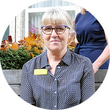- OT
- Professional support
- Health services
- "As the situation escalated professional boundaries became irrelevant"
Perspectives
"As the situation escalated professional boundaries became irrelevant"
A team-led approach to crisis management during the pandemic, by Birmingham and Midland Eye Centre’s Dr Waheeda Illahi, Rosie Auld and Dr Peter Good
6 min read

Here in the Midlands, we have unfortunately seen one of the highest number of deaths associated with the coronavirus (COVID-19) pandemic. The Birmingham & Midland Eye Centre (BMEC) is a supra-regional tertiary referral centre accepting ophthalmology referrals from a large geographical area. It is also part of the Sandwell & West Birmingham NHS Trust (SWBH), located in a region that has become one of England’s COVID-19 hot spots.
Optometrists, orthoptists, clinical scientists, ophthalmic technicians, advanced nurse practitioners, as well as other allied health professionals (AHPs), normally provide core and extended role services. These include emergency, corneal, glaucoma, medical retina, vitreo-retinal, neuro-ophthalmology, and genetics, as well as other ophthalmology sub-speciality services.
Uncertainty and the rapidly changing situation fuelled the anguish of the early days as heads of services became aware of the reality of re-deployment of their teams to support an anticipated surge in COVID-19 patients.
With schools and community optometric practices closing, patients stopped attending their hospital outpatient appointments and parents chose not to bring their children for fear of catching the virus. The number of patients attending eye casualty also reduced significantly.
Being part of a large acute trust with rapidly developing COVID plans meant that, as the situation escalated, professional boundaries became irrelevant and ophthalmology services could no longer remain in isolation from the trust’s contingency response. There was a real fear of the unknown, in particular a fear of what risks staff may be exposed to. Proposals were made for optometrists, orthoptists, clinical scientists and other AHPs to be re-deployed to replace nursing staff so that they could move to the front line.
Heads of service were given the task of undertaking one-to-one meetings with staff to inform them that they were likely to be re-deployed and in some cases had to discuss highly confidential health information with staff who potentially required shielding. Staff were then expected to inform their families that they may be redeployed into high risk COVID zones. It was not known where they would go or when.
Everything stopped except urgent patients as emergency standard operating procedures were adopted. The optometry department continued to see bandage and extended contact lens wearers, the orthoptic department continued to support stroke and urgent paediatric and neuro-ophthalmology patients, and the vision science team continued to perform urgent ultrasound scans.
As community practices continue to remain closed for routine sight tests, the hospital optometry department is starting to resume paediatric refractions in addition to urgent contact lens assessments. Patients who had been fitted with complex contact lenses but needed to be seen for their teaching session prior to lenses being issued will be given priority and reviewed in the coming days. Almost every patient on the optometry waiting list has received a telephone consultation. The lockdown has given patients who wear therapeutic contact lenses for extended periods of time an opportunity to reduce their wearing times and those no longer having to commute long distances to work have reported improvement in symptoms. Optometrists have been able to provide important advice on preventing contact lens related complications as well as counselling support to low vision patients. The optical dispensary has continued to remain open throughout the pandemic, providing support to key workers and NHS personnel.
Three of the orthoptists are currently working as chaperones in the breast service. The orthoptic service continues to undertake telephone and video consultations in addition to providing a face to face urgent and emergency service for paediatric, orthoptic and neuro-ophthalmic patients. In May, the service commenced a phased restoration and recovery process by inviting small numbers of less urgent patients to attend face to face appointments. The aim is a gradual increase in patient numbers week on week.
The COVID crisis has affected many services in ophthalmology. As the region’s only paediatric ocular electrophysiology service where children of all ages are referred from as far away as the Welsh Coast and Derbyshire, we have had to put this unique service on hold. This has been a very stressful time for the parents of these children, especially those with very young children with unexplained visual loss and undiagnosed nystagmus. An adjunct to this is the cessation of the regional genetics service which is located at the BMEC. Parents and other family members of children with inherited eye disease rely on this service in order to obtain genetic counselling, and to obtain DNA analysis of their family's phenotype. Such analysis is vital for genetic counselling purposes but also for entering children and adults into future gene therapy trials, some of which are starting in Birmingham.
The pandemic will permanently affect the provision of ophthalmology services in the future. There will be increased use of artificial intelligence, virtual telephone and video reviews; already useful for children post refraction to check on compliance with glasses wear and in services such as low vision in order to reduce patient visits to hospitals.
In the immediate future, ensuring social distancing in waiting areas, appropriate and adequate PPE and regaining patient confidence remain the challenges for heads of service. The increased pressure on individuals has highlighted the value of sharing problems, discussing solutions, and the ongoing need for a team approach.
Optometrists, orthoptists, clinical scientists, ophthalmic technicians, advanced nurse practitioners, as well as other allied health professionals (AHPs), normally provide core and extended role services. These include emergency, corneal, glaucoma, medical retina, vitreo-retinal, neuro-ophthalmology, and genetics, as well as other ophthalmology sub-speciality services.
A rapid response
As the number of deaths started to increase and the country went into lockdown, SWBH immediately started to expand its intensive care unit capacity. Within days, trauma, cancer, maternity and paediatric services were relocated to provide capacity for increasing demand of intensive care beds. Many theatre staff from BMEC, including anaesthetists and theatre nurses, were re-deployed to support the frontline. All elective surgery was placed on hold, and as the situation intensified the only eye ward supporting all of the ophthalmology departments in the region was closed and emergency ophthalmic in-patients were moved to general wards and sub-divided into COVID and non-COVID.Uncertainty and the rapidly changing situation fuelled the anguish of the early days as heads of services became aware of the reality of re-deployment of their teams to support an anticipated surge in COVID-19 patients.
With schools and community optometric practices closing, patients stopped attending their hospital outpatient appointments and parents chose not to bring their children for fear of catching the virus. The number of patients attending eye casualty also reduced significantly.
Being part of a large acute trust with rapidly developing COVID plans meant that, as the situation escalated, professional boundaries became irrelevant and ophthalmology services could no longer remain in isolation from the trust’s contingency response. There was a real fear of the unknown, in particular a fear of what risks staff may be exposed to. Proposals were made for optometrists, orthoptists, clinical scientists and other AHPs to be re-deployed to replace nursing staff so that they could move to the front line.
Heads of service were given the task of undertaking one-to-one meetings with staff to inform them that they were likely to be re-deployed and in some cases had to discuss highly confidential health information with staff who potentially required shielding. Staff were then expected to inform their families that they may be redeployed into high risk COVID zones. It was not known where they would go or when.
Everything stopped except urgent patients as emergency standard operating procedures were adopted. The optometry department continued to see bandage and extended contact lens wearers, the orthoptic department continued to support stroke and urgent paediatric and neuro-ophthalmology patients, and the vision science team continued to perform urgent ultrasound scans.
Where we are now
In our hospital, two full time optometrists continue to support hospital wards containing COVID patients. Acting in an administrative role, the optometrists provide vital links to relatives and other health professionals where there is restricted access to the ward. For patients who are unwell, the optometrists help with dialling telephones and facilitating video conferences with family members. Staff have demonstrated a flexible and adaptable approach, providing a surprisingly stoic and philosophical response. They have adapted to working in a different multi-disciplinary team, adjusting to the dynamics of a hospital ward and have gained a different skill set.In our hospital, two full time optometrists continue to support hospital wards containing COVID patients. Acting in an administrative role, the optometrists provide vital links to relatives and other health professionals
As community practices continue to remain closed for routine sight tests, the hospital optometry department is starting to resume paediatric refractions in addition to urgent contact lens assessments. Patients who had been fitted with complex contact lenses but needed to be seen for their teaching session prior to lenses being issued will be given priority and reviewed in the coming days. Almost every patient on the optometry waiting list has received a telephone consultation. The lockdown has given patients who wear therapeutic contact lenses for extended periods of time an opportunity to reduce their wearing times and those no longer having to commute long distances to work have reported improvement in symptoms. Optometrists have been able to provide important advice on preventing contact lens related complications as well as counselling support to low vision patients. The optical dispensary has continued to remain open throughout the pandemic, providing support to key workers and NHS personnel.
Three of the orthoptists are currently working as chaperones in the breast service. The orthoptic service continues to undertake telephone and video consultations in addition to providing a face to face urgent and emergency service for paediatric, orthoptic and neuro-ophthalmic patients. In May, the service commenced a phased restoration and recovery process by inviting small numbers of less urgent patients to attend face to face appointments. The aim is a gradual increase in patient numbers week on week.
The pandemic will permanently affect the provision of ophthalmology services in the future. There will be increased use of artificial intelligence, virtual telephone and video reviews
The COVID crisis has affected many services in ophthalmology. As the region’s only paediatric ocular electrophysiology service where children of all ages are referred from as far away as the Welsh Coast and Derbyshire, we have had to put this unique service on hold. This has been a very stressful time for the parents of these children, especially those with very young children with unexplained visual loss and undiagnosed nystagmus. An adjunct to this is the cessation of the regional genetics service which is located at the BMEC. Parents and other family members of children with inherited eye disease rely on this service in order to obtain genetic counselling, and to obtain DNA analysis of their family's phenotype. Such analysis is vital for genetic counselling purposes but also for entering children and adults into future gene therapy trials, some of which are starting in Birmingham.
The pandemic will permanently affect the provision of ophthalmology services in the future. There will be increased use of artificial intelligence, virtual telephone and video reviews; already useful for children post refraction to check on compliance with glasses wear and in services such as low vision in order to reduce patient visits to hospitals.
In the immediate future, ensuring social distancing in waiting areas, appropriate and adequate PPE and regaining patient confidence remain the challenges for heads of service. The increased pressure on individuals has highlighted the value of sharing problems, discussing solutions, and the ongoing need for a team approach.
About the authors
Dr Waheeda Illahi is head of optometry services. Rosie Auld CBE is head of orthoptic services. Dr Peter Good is a consultant neurophysiologist.




Comments (0)
You must be logged in to join the discussion. Log in